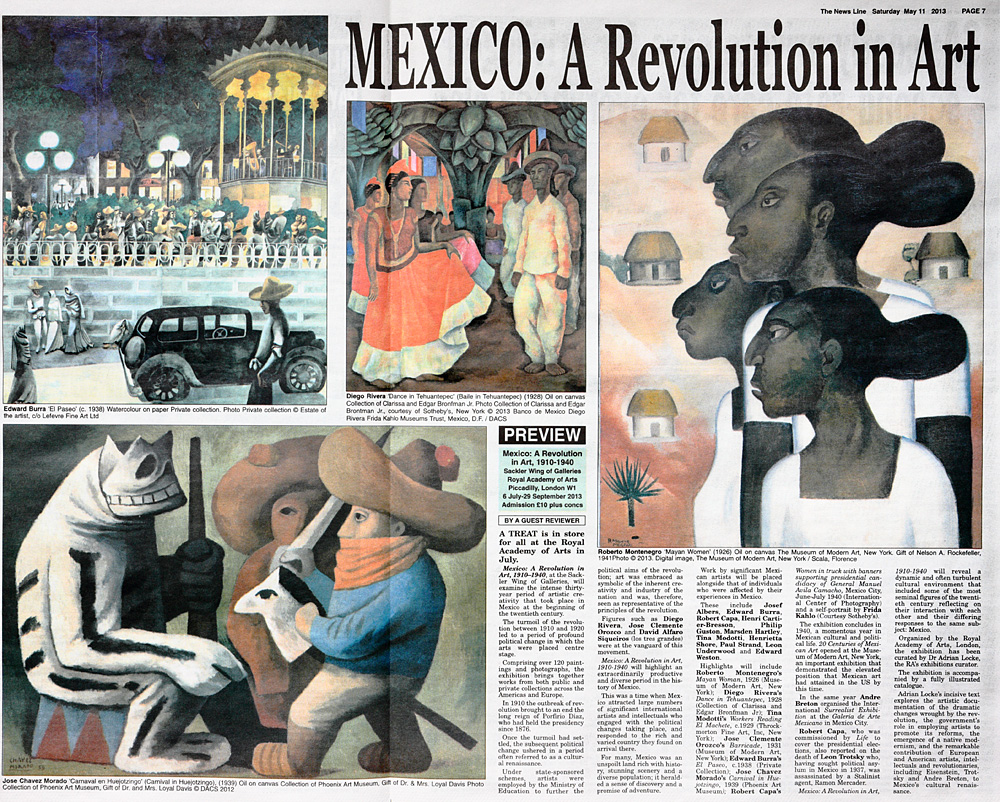 |
| The News Line Saturday May 11
2013 PAGE 7 MEXICO: A Revolution in Art PREVIEW Mexico: A Revolution in Art, 1910-1940 Sackler Wing of Galleries Royal Academy of Arts Piccadilly, London W1 6 July-29 September 2013 Admission 10 UK pounds plus concs BY A GUEST REVIEWER A TREAT is in store for all at the Royal Academy of Arts in July. Mexico: A Revolution in Art, 1910--1940, at the Sackler Wing of Galleries, will examine the intense thirty-year period of artistic creativity that took place in Mexico at the beginning of the twentieth century. The turmoil of the revolution between 1910 and 1920 led to a period of profound political change in which the arts were placed centre stage. Comprising over 120 paintings and photographs, the exhibition brings together works from both public and private collections across the Americas and Europe. In 1910 the outbreak of revolution brought to an end the long reign of Porfirio Diaz, who had held the presidency since 1876. Once the turmoil had settled, the subsequent political change ushered in a period often referred to as a cultural renaissance. Under state-sponsored schemes, artists were employed by the Ministry of Education to further the political aims of the revolution; art was embraced as symbolic of the inherent creativity and industry of the nation and was, therefore, seen as representative of the principles of the revolution. Figures such as Diego Rivera, Jose Clemente Orozco and David Alfaro Siqueiros (los tres grandes) were at the vanguard of this movement. Mexico: A Revolution in Art, 1910-1940 will highlight an extraordinarily productive and diverse period in the history of Mexico. This was a time when Mexico attracted large numbers of significant international artists and intellectuals who engaged with the political changes taking place, and responded to the rich and varied country they found on arrival there. For many, Mexico was an unspoilt land rich with history, stunning scenery and a diverse population; it heralded a sense of discovery and a promise of adventure. Work by significant Mexican artists will be placed alongside that of individuals who were affected by their experiences in Mexico. These include Josef Albers, Edward Burra, Robert Capa, Henri Cartier-Bresson, Philip Guston, Marsden Hartley, Tina Modotti, Henrietta Shore, Paul Strand, Leon Underwood and Edward Weston. Highlights will include Roberto Montenegro's Mayan Woman, 1926 (Museum of Modern Art, New York); Diego Rivera's Dance in Tehuantepec, 1928 (Collection of Clarissa and Edgar Bronfman .Jr); Tina Modotti's Workers Reading El Machete, c.1929 (Throckmorton Fine Art, Inc, New York); Jose Clemente Orozco's Barricade, 1931 (Museum of Modern Art, New York); Edward Burra's El Paseo, c.1938 (Private Collection); Jose Chavez Morado's Carnival in Huejotzingo , 1939 (Phoenix Art Museum): Robert Capa's Women in truck with banners supporting presidential candidacy of General Manuel Avila Camacho, Mexico City, June-July 1940 (International Center of Photography) and a self-portrait by Frida Kahlo (Courtesy Sotheby's). The exhibition concludes in 1940, a momentous year in Mexican cultural and political life. 20 Centuries of Mexican Art opened at the Museum of Modern Art, New York, an important exhibition that demonstrated the elevated position that Mexican art had attained in the US by this time. In the same year Andre Breton organised the International Surrealist Exhibition at the Galeria de Arte Mexicano in Mexico City. Robert Capa, who was commissioned by Life to cover the presidential elections, also reported on the death of Leon Trotsky who, having sought political asylum in Mexico in 1937, was assassinated by a Stalinist agent, Ramon Mercader. Mexico: A Revolution in Art, 1910-1940 will reveal a dynamic and often turbulent cultural environment that included some of the most seminal figures of the twentieth century reflecting on their interaction with each other and their differing responses to the same subject: Mexico. Organized by the Royal Academy of Arts, London, the exhibition has been curated by Dr Adrian Locke, the RAs exhibitions curator, The exhibition is accompanied by a fully illustrated catalogue. Adrian Locke's incisive text explores the artistic documentation of the dramatic changes wrought by the revolution, the government's role in employing artists to promote its reforms, the emergence of a native modernism, and the remarkable contribution of European and American artists, intellectuals and revolutionaries, including Eisenstein, Trotsky and Andre Breton, to Mexico's cultural renaissance. http://www.wrp.org.uk |